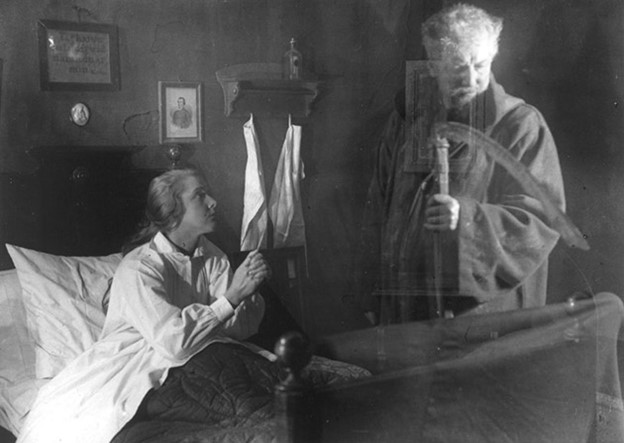The Phantom Carriage (1921)
Victor Sjostrom's "The Phantom Carriage"
After the successes of "A Man There Was" and "The Outlaw and His Wife," Victor Sjostrom decided to move away from his outdoor melodramas and do something more urban and gritty. Having already adapted three of Selma Lagerlof's novels, Sjostrom made it four with "Korkarlen." The 1912 novel deals with occultism and mysticism, and would provide a definite challenge to Sjostrom's simplistic approach. After its release, the film would become a global phenomenon and would merit Sjostrom's enlistment in the Hollywood system.
The film opens on a dying woman named Sister Edit as she spends her New Year's Eve on her death bed at the Salvation Army. Her dying wish is to speak with David Holm. David, a drunkard, sits at a graveyard with two friends and recounts the story of an old friend named Georges, whom years ago told him a story of the 'Phantom Carriage.' Through flashback, we are shown Georges as he recounts to David the ghost story. Every year on New Year's Eve, the last person to die before the stroke of midnight is greeted by the Phantom Carriage and its ghostly rider. The deceased must take over the post of rider and spend the next full year collecting dead souls. After telling this story, David remarks that Georges himself died on New Year's. Upon learning that Sister Edit calls out for him, the two men try and get David to go to her. However, he refuses. A fight breaks out and one of the men knocks David out with a bottle. Just then, at the stroke of midnight, the Phantom Carriage arrives with Georges as the driver. Georges recounts to David his past, as Sjostrom takes us through various flashbacks. The flashbacks show us a happy David with his family. We then see their relationship disintegrate, as David falls into alcoholism. After spending time in prison, David's family leaves him. He then becomes a total degenerate until he eventually ends up at the Salvation Army with Sister Edit, who tends to him. Despite his crude and transgressive behavior, Sister Edit tells David to return to him next New Year's so that she may see how the Lord has blessed him. He agrees. Before the next year arrives, Sister Edit reunites David with his long lost family. However, after reconciling, David falls back into alcoholic behavior and even begins to abuse and berate both his wife and children. Back in the present, Georges takes David to visit Sister Edit, who is dying from tuberculosis that she contracted from David. Upon seeing David's regret for his past sins, she dies. Georges then takes David to see his ex-wife about to commit suicide and poison the children. Just then, David wakes up from his unconsciousness and saves his wife from this dark fate.
At the time in 1921, war had just ended in Europe a couple years prior. Alcoholism and social degeneration was a huge problem for Swedish citizens. Not only this, Sjostrom's strained relationship with his father was due to his alcoholism and abusive behavior. The rendering of David is perhaps related to Sjostrom's perspective on his father. The film reflects the horrible effects alcoholic indulgence, as well as a general brutishness of its protagonist. The arrival of the carriage, which obviously represents death, presents a perspective on this wasted life. Not only this, it allows David to view the effects of his behavior in their totality.
The structure and visuals of the film also reflect this drunken state. The frame of the story, David and the carriage, is surrounded by varied flashbacks. This lack of contextual time-hopping may have confused many audiences both at the time and now, but it allows for the flow of the film to resemble David's confused state.
The scenes involving the Phantom Carriage are perhaps the most creative visual effects ever put to screen up until that point. The images of the ghostly visages are relatively 'see-through' as they walk around in the frame, superimposed on the original images. This effect was created using double exposures by cinematographer Julius Jaenzon. He used hand cranked cameras, all cranking at the same speed rate. The hand-moved camera followed each character, lighting them differently and using different filters. The images then had to be superimposed four times upon the original image. The effects were uncanny. The ghosts appeared to move within the frame, either behind other characters or in front of solid foreground objects. With this effect, the ghosts are able to obtain a dimensionality, enhancing the realism.





Comments
Post a Comment